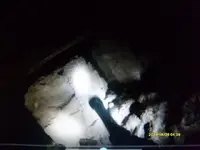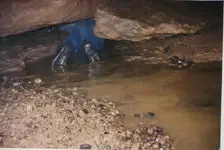Your right.... it's hanging in mid air. That one and the small ones around it are the ONLY ones I ever saw. But this pic was taken near the very end of the cave. I went maybe another 15 minutes on my stomach and couldn't even turn around. Had to crawl backwards.
Finding stalactites that are hanging in mid air indicates-
1-The floor has dropped/fallen.
2-The floor has been washed out. Usually not even. Has ruts and dips like a small grand canyon. It can be smooth if it washes to the next rock layer. But it usually shows water wear on that next layer.
3-The ceiling has pulled up. This is rare but I've seen a couple places that this has happened.
4-Part of the stalactite has been taken.
From the other pictures of the squares and the stalactites.
It appears that most of the cave floor/rock layer has fallen.
The floor pulled loose from the stalactites because they were attached to tumble down(rocks/debris that has fallen from the ceiling) or sediment.
The floor falling made headspace above the blocks of whatever-they-are.
Then the floor was washed by the flowing stream.
This is all surmise of course. Based on other caves I have explored/studied.
It does appear that this cave was mined or dug in at some time. Squared off sides of debris piles, marks on the walls,etc.
Why and when has yet to be determined.
Edits for clarity





